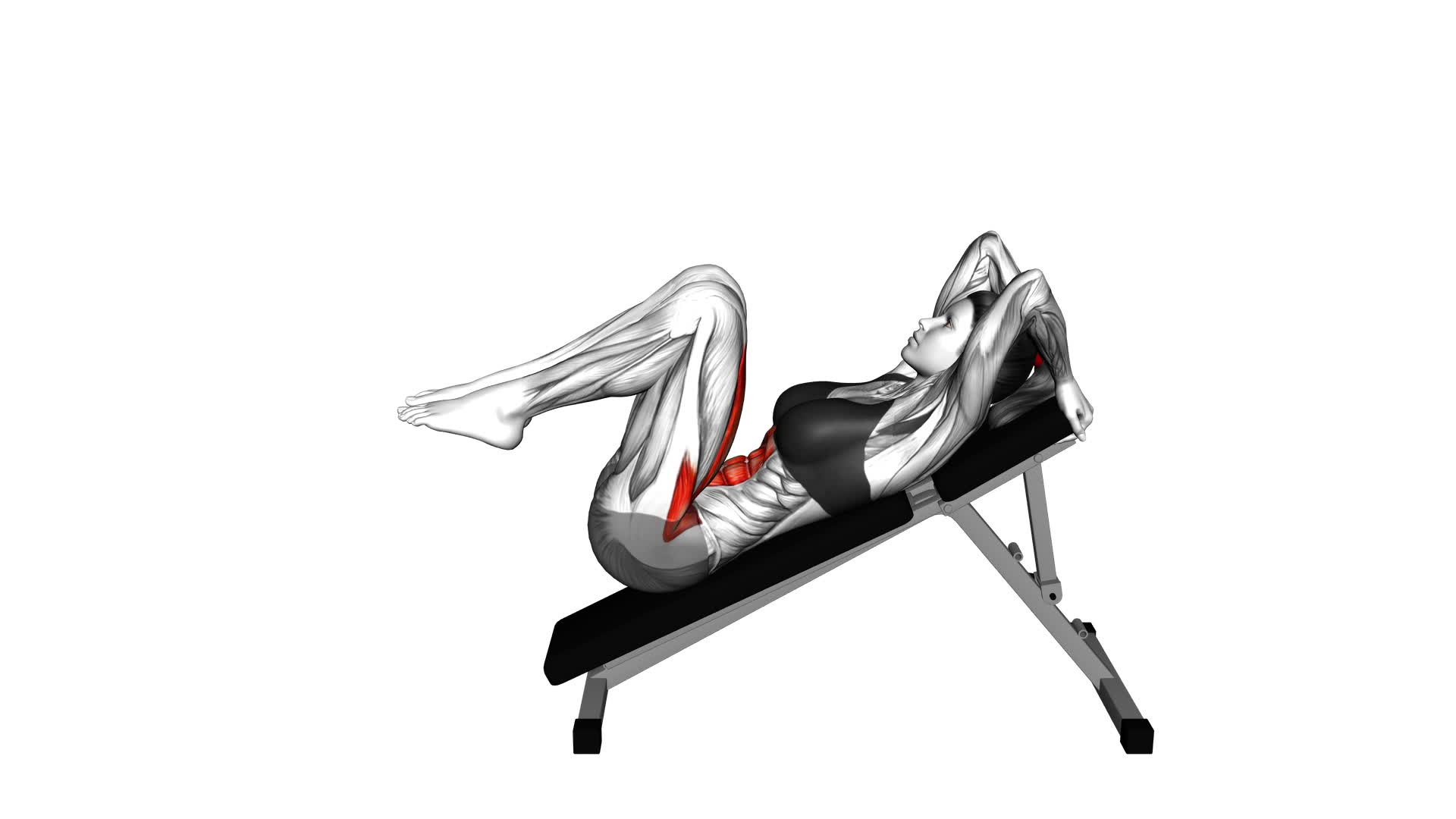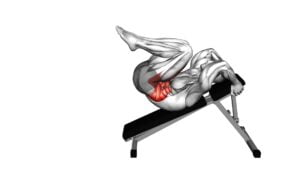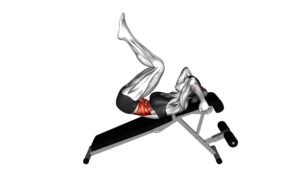Decline Knee Raise (female) – Video Exercise Guide & Tips

Get ready to sculpt your abs and strengthen your core with the decline knee raise!
Watch This Exercise Video
This exercise is perfect for targeting your lower abs and building overall core stability.
In this video exercise guide, you'll find step-by-step instructions and helpful tips to ensure proper form and technique.
Whether you're a beginner or advanced, incorporating the decline knee raise into your workout routine will bring you one step closer to achieving your fitness goals.
Let's get started!
Key Takeaways
- Targets lower abs
- Builds overall core stability
- Allows for full range of motion and greater contraction in abs
- Improves stability and balance
Benefits of Decline Knee Raise
To maximize the effectiveness of your workout, engage your abdominal muscles by incorporating the decline knee raise into your routine. The decline knee raise is a powerful exercise that targets your lower abs and helps to strengthen your core.
One of the main benefits of this exercise is that it allows you to fully engage your abdominal muscles through a full range of motion. By raising your knees towards your chest while on a decline bench, you're able to create a greater contraction in your abs compared to traditional floor exercises. This increased muscle activation leads to stronger and more defined abs over time.
Another benefit of the decline knee raise is that it helps to improve your overall stability and balance. By performing this exercise on a decline bench, you're challenging your core to stabilize your body throughout the movement. This not only works your abs, but also engages your hip flexors and lower back muscles.
Variations and modifications for the decline knee raise can be made to increase or decrease the difficulty level. For beginners, it's advisable to start with bent knee raises instead of straight leg raises. This modification allows you to focus on proper form and build strength before progressing to more advanced variations. On the other hand, for those looking for a challenge, you can add weights to your ankles or perform a twisting motion at the top of the movement to engage your obliques.
Equipment Needed for Decline Knee Raise
To perform the decline knee raise, you'll need a decline bench and a stable surface to anchor your feet. These two pieces of equipment are essential for executing the exercise correctly and safely.
Here are three important items to consider when it comes to equipment for the decline knee raise:
- Decline Bench: A decline bench is designed specifically for exercises like the decline knee raise. It allows you to lie down at an angle, with your head lower than your feet. Look for a bench that's sturdy and adjustable so you can set it to the desired decline angle.
- Stable Surface: In addition to the decline bench, you'll need a stable surface to anchor your feet. This can be a foot bar or foot straps attached to the bench, or you can use a separate piece of equipment like a stability ball or ab slings. The important thing is to have a secure anchor point for your feet.
- Decline Knee Raise Modifications and Equipment Alternatives: If you don't have access to a decline bench, there are alternatives you can try. You can perform knee raises on a flat bench or even on the floor. Additionally, if you don't have access to foot bars or straps, you can use a resistance band or a partner to hold your feet in place.
Now that you know the equipment needed for the decline knee raise, let's move on to the next section, which will cover the proper form and technique for performing this exercise.
Proper Form and Technique for Decline Knee Raise
Now let's dive into the proper form and technique for the decline knee raise exercise.
To perform this exercise correctly, start by lying on a decline bench with your head at the lower end and secure your feet under the pads. Place your hands beside your hips or under your glutes for support. Engage your core and lift your knees towards your chest, while keeping your back flat and your legs together. Pause at the top for a moment and then slowly lower your legs back down to the starting position.
When performing the decline knee raise, there are a few common mistakes to avoid.
First, be careful not to swing your legs or use momentum to lift them up. This can take the focus away from your abs and reduce the effectiveness of the exercise. Additionally, avoid arching your back or straining your neck during the movement. To maintain proper form, keep your core engaged and your back flat throughout the entire exercise.
Progression levels for the decline knee raise can be adjusted to suit your fitness level.
Beginners can start by focusing on proper form and completing a few repetitions. As you become more comfortable, you can increase the number of repetitions or add resistance by holding a dumbbell between your feet. Advanced individuals can try more challenging variations, such as straight leg raises or twisting knee raises.
Remember to always listen to your body and stop if you feel any pain or discomfort.
Variations and Modifications for Decline Knee Raise
Now let's explore some alternative knee exercises that you can try if the decline knee raise isn't suitable for you.
Additionally, we'll look at different equipment options that can be used to modify the exercise and make it more challenging or accessible.
Lastly, we'll discuss progression levels specifically designed for beginners to gradually build strength and improve their form.
Alternative Knee Exercises
Looking for different ways to work your knees? How can you modify the decline knee raise exercise for an added challenge or variation? Here are three alternative knee exercises that can help strengthen your knees and improve knee stability:
- Single-leg squat: Stand on one leg and slowly lower your body down as if sitting on a chair, then rise back up. This exercise targets the muscles around the knee joint and helps improve stability.
- Step-ups: Find a step or platform and step up onto it with one leg, then step back down. Repeat on the other leg. This exercise works the muscles in your thighs and hips, providing support to your knees.
- Wall sits: Stand with your back against a wall and lower your body down until your knees are bent at a 90-degree angle. Hold this position for as long as you can. Wall sits are great for strengthening your quadriceps, which are crucial for knee stability.
Now that you have some alternative knee exercises to try, let's move on to the next section about equipment for modifications.
Equipment for Modifications
To modify the decline knee raise exercise, you can utilize different pieces of equipment. One option is to use ankle weights, which can add resistance to the movement and make it more challenging.
Another option is to use a stability ball, placing it between your lower legs and squeezing it as you perform the knee raise. This helps engage the muscles in your lower body even more.
Additionally, you can use a decline bench with adjustable settings to vary the angle at which you perform the exercise. This allows you to target different muscle groups and adjust the difficulty level according to your fitness level.
Remember to maintain proper technique and form while using equipment modifications to ensure effective and safe workouts.
Now, let's move on to the next section about progression levels for beginners.
Progression Levels for Beginners
To progress as a beginner, start with a low number of repetitions for the decline knee raise exercise and gradually increase the intensity over time. This will allow your body to adapt and become stronger.
Here are three progression levels and exercise modifications to help you advance in your workout:
- Increase the number of repetitions: Start with 5-10 repetitions and aim to gradually increase to 15-20 repetitions per set. This will challenge your muscles and improve your strength and endurance.
- Extend your legs: Once you feel comfortable with the basic decline knee raise, try extending your legs fully. This will engage your core muscles even more and increase the difficulty of the exercise.
- Add weights: To further intensify your workout, you can hold a dumbbell or a medicine ball between your feet while performing the decline knee raise. This will add resistance and help build strength in your abdominal muscles.
Remember to listen to your body and progress at a pace that feels challenging but still manageable.
Tips for Getting the Most Out of Decline Knee Raise
To maximize your results with the decline knee raise, focus on proper form and engaging your core muscles throughout the exercise. This will ensure that you're targeting the right muscles and getting the most out of each repetition. Here are a few tips to help you get the most out of this exercise:
- Maintain proper form: Make sure your back is flat against the decline bench and your legs are fully extended. Keep your core engaged and avoid swinging your legs or using momentum to lift them.
- Control the movement: Slowly raise your knees towards your chest, focusing on using your abdominal muscles to lift your legs. Avoid using your hip flexors or relying on your lower back to complete the movement.
- Increase difficulty: Once you have mastered the basic decline knee raise, you can try some advanced techniques to challenge your core even more. This may include adding ankle weights or performing the exercise with straight legs instead of bent knees.
- Explore alternative exercises: If you find the decline knee raise too challenging or want to switch up your routine, there are alternative exercises you can try. Hanging knee raises, captain's chair leg raises, or seated knee tucks are all great options that target the same muscles.
Common Mistakes to Avoid During Decline Knee Raise
Avoid these common mistakes when performing the decline knee raise to ensure proper form and maximize the effectiveness of the exercise.
- Swinging your legs: One of the most common mistakes during decline knee raises is swinging your legs instead of using controlled movements. This not only reduces the effectiveness of the exercise but also puts strain on your lower back. To avoid this, focus on engaging your core muscles and using slow, controlled movements throughout the exercise.
- Lifting your hips: Another mistake to avoid is lifting your hips off the bench during the exercise. This takes the focus away from your abdominal muscles and shifts it to your hip flexors. To maintain proper form, keep your hips in contact with the bench at all times and concentrate on using your abs to lift your knees towards your chest.
- Not breathing properly: Breathing plays a crucial role in any exercise, and decline knee raises are no exception. One common mistake is holding your breath or breathing shallowly during the movement. Remember to inhale as you lower your legs and exhale as you raise them, ensuring a steady flow of oxygen to your muscles and helping you maintain proper form and technique.
Frequently Asked Questions
How Many Sets and Reps Should I Do for Decline Knee Raises?
For decline knee raises, you should aim for around 3-4 sets of 10-12 reps per set. This will help target your lower abs and improve core strength.
By incorporating this exercise into your routine, you can experience several benefits such as increased abdominal muscle definition, improved posture, and enhanced stability.
Remember to start with a weight that challenges you but allows for proper form, and gradually increase as you get stronger.
Can I Do Decline Knee Raises if I Have a Pre-Existing Knee Injury?
If you have a pre-existing knee injury, it's important to consult with a medical professional before attempting decline knee raises. There may be alternative exercises that can help target the same muscle groups without putting strain on your knees.
Additionally, modifications for knee injuries, such as using a stability ball or performing assisted knee raises, may be recommended.
Prioritizing safety and proper form is crucial to prevent further injury and promote healing.
Can Decline Knee Raises Help With Weight Loss or Toning the Abs?
Decline knee raises are a great exercise for weight loss and toning the abs. Compared to other ab exercises, they're highly effective in targeting the lower abs and strengthening the core.
To get the maximum results, incorporate decline knee raises into a comprehensive workout routine that includes a combination of cardio, strength training, and flexibility exercises. This will help you burn calories, build lean muscle, and achieve a toned stomach.
Is It Necessary to Use a Decline Bench for Decline Knee Raises, or Can I Do Them on a Flat Bench?
Using a flat bench for decline knee raises isn't necessary, but it can be done. However, using a decline bench offers more benefits for core strength.
The decline angle engages your lower abs more effectively, resulting in better muscle activation and toning. It also increases the challenge of the exercise, making it more effective for building strength and definition in your abs.
Are There Any Alternatives to Decline Knee Raises That Target the Same Muscles?
If you're looking for alternatives to decline knee raises that target the same muscles, there are a few options you can try.
One option is hanging leg raises, which work your abs and hip flexors.
Another alternative is captain's chair leg raises, where you hang from parallel bars and raise your knees towards your chest.
Both of these exercises offer similar benefits to decline knee raises, such as strengthening your core and improving stability.
Conclusion
In conclusion, the decline knee raise is a highly effective exercise for targeting the abdominal muscles, particularly the lower abs. By using proper form and technique, and incorporating variations and modifications as needed, you can maximize the benefits of this exercise.
Remember to avoid common mistakes and follow the tips provided to get the most out of your decline knee raise workout. Stay consistent and dedicated, and you'll see results in no time.

Author
Years ago, the spark of my life’s passion ignited in my mind the moment I stepped into the local gym for the first time. The inaugural bead of perspiration, the initial endeavor, the very first surge of endorphins, and a sense of pride that washed over me post-workout marked the beginning of my deep-seated interest in strength sports, fitness, and sports nutrition. This very curiosity blossomed rapidly into a profound fascination, propelling me to earn a Master’s degree in Physical Education from the Academy of Physical Education in Krakow, followed by a Sports Manager diploma from the Jagiellonian University. My journey of growth led me to gain more specialized qualifications, such as being a certified personal trainer with a focus on sports dietetics, a lifeguard, and an instructor for wellness and corrective gymnastics. Theoretical knowledge paired seamlessly with practical experience, reinforcing my belief that the transformation of individuals under my guidance was also a reflection of my personal growth. This belief holds true even today. Each day, I strive to push the boundaries and explore new realms. These realms gently elevate me to greater heights. The unique combination of passion for my field and the continuous quest for growth fuels my drive to break new ground.







